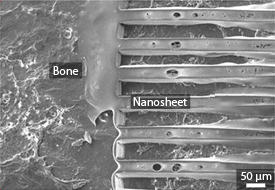

08/25/2014

© 2014 WILEY-VCH Verlag GmbH & Co. KGaA, Weinheim
The surfaces of bones are often covered with a thin membrane, which is known as the periosteum. As well as providing mechanical strength and support, the periosteum is actively involved in the regeneration of injured bones. Osteoblasts — the major cellular component of bone — are produced by the differentiation of stem cells residing in this membrane. However, tissue engineering strategies for bone repair rarely consider this component of bone.
Inspired by the microstructure of the periosteum, Xuetao Shi and co-workers from the AIMR at Tohoku University and other institutions from around the world have fabricated an artificial periosteum by using patterned polymeric nanosheets1. This material is suitable for use in bone repair therapies. Natural periosteum consists of longitudinally oriented cells and collagen fibers, and the researchers mimicked this topography by fabricating nanosheets of poly(lactic-co-glycolic acid), or PLGA, which contain grooves with a spacing of about 50 micrometers.
Shi and his colleagues were able to noncovalently anchor the PLGA nanosheets to a variety of materials related to bone and bone repair, including a chicken wing bone, titanium alloy implants, and macroporous and microporous bioceramic tissue engineering scaffolds (see image). Promisingly, the researchers found that their nanosheets were difficult to detach from these surfaces. Furthermore, fluorescence microscopy revealed that the grooves in the nanosheets were preserved even after the sheets had adhered to bone or bone scaffolds — something that is important for correctly aligning stem cells.
To test whether the PLGA nanosheets would be suitable for stimulating bone regeneration, the team seeded human mesenchymal stem cells capable of differentiating into bone onto the artificial periosteum. When they did this, they found that the stem cells aligned themselves in a parallel orientation to the grooves.
“The results indicate that the artificial periosteum not only acts a reservoir of stem cells for bone regeneration, but also controls the number of stem cells that become bone cells,” explains Shi. Moreover, the microgrooved patterns on the nanosheets help direct protein and gene expression levels of the cultured cells in a similar way to natural periosteum, which is important for achieving effective bone repair.
The researchers are now planning to investigate the bone-generating properties of stem cells on the microgrooved nanosheets in animals. They expect that when the PLGA nanosheets are adhered to porous, tissue-engineering scaffolds, the nanosheets will degrade over the course of a month — a sufficiently long period for the stem cells to correctly align and differentiate into osteoblasts.
Shi, X., Fujie, T., Saito, A., Takeoka, S., Hou, Y., Shu, Y., Chen, M., Wu, H. & Khademhosseini, A. Periosteum-mimetic structures made from freestanding microgrooved nanosheets. Advanced Materials 26, 3290–3296 (2014). | article
This research highlight has been approved by the authors of the original article and all information and data contained within has been provided by said authors.